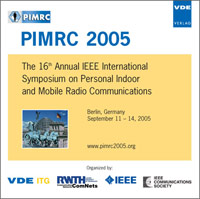Impact of Angular Spread on Higher Order Sectorization in WCDMA Systems
Konferenz: PIMRC 2005 - 16th Annual IEEE International Symposium on Personal Indoor and Mobile Radio Communications
11.09.2005 - 14.09.2005 in Berlin, Germany
Tagungsband: PIMRC 2005
Seiten: 5Sprache: EnglischTyp: PDF
Persönliche VDE-Mitglieder erhalten auf diesen Artikel 10% Rabatt
Autoren:
Osseiran, Afif; Logothetis, Andrew (Ericsson Research, 164 80 Stockholm, Sweden)
Inhalt:
This paper analyzes higher order sectorization (HOS) in WCDMA. Sectorization is achieved by splitting the sites into smaller sectors using highly directional antennas. The impact of angular spread on the system throughput is evaluated using a dynamic radio network simulator. Increasing the number of sectors per site from 3 to 6 and 12 in a typical urban radio channel, yields a downlink system capacity gain of 80% and 200% respectively. Simulations have shown that the increase in the ratio of users in soft and softer handover per sector is negligible and the impact of angular spread on the system performance of a 6 and 12 sector sites is minor and negligible for the 3 sector sites.


